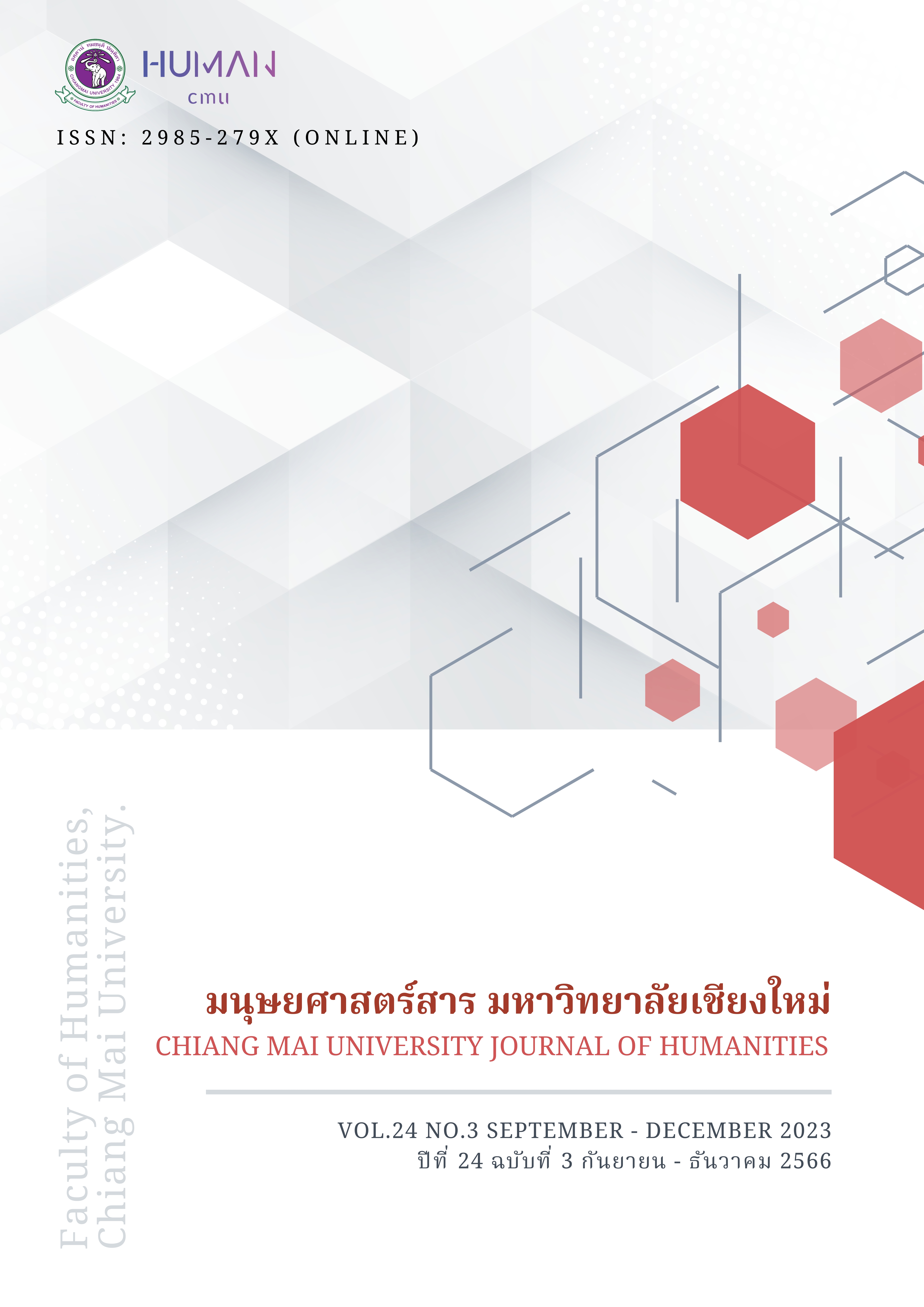การ ถ่ายทอดภาษาฝรั่งเศสในครอบครัวฝรั่งเศส-ไทย : การใช้ภาษาและการตั้งชื่อลูก
Main Article Content
บทคัดย่อ
บทความนี้มีวัตถุประสงค์เพื่อนำเสนอผลการวิจัยทางด้านภาษาศาสตร์สังคม ซึ่งได้ดำเนินการในประเทศไทยระหว่างปีค.ศ. 2022 ถึงค.ศ. 2023 เป็นการศึกษาว่ามีการสืบทอดภาษาฝรั่งเศสจากรุ่นพ่อหรือแม่ชาวฝรั่งเศสถึงลูกซึ่งเป็นลูกครึ่งฝรั่งเศส-ไทย หรือเป็นไทยแท้หรือไม่อย่างไร ซึ่งทั้งนี้ระบุให้เป็นลูกที่พ่อแม่เป็นผู้เลี้ยงดูหลัก ข้อมูลที่นำไปวิเคราะห์ในงานวิจัยมาจากแบบสอบถามชาวฝรั่งเศสที่อาศัยอยู่ในภูมิภาคต่าง ๆ ของประเทศไทย ผลจากการวิจัยพบว่า พ่อแม่ชาวฝรั่งเศสใช้ภาษาอังกฤษเป็นหลักในการสื่อสารระหว่างกัน โดยอาจใช้ภาษาอังกฤษภาษาเดียวหรืออาจใช้ร่วมกับภาษาไทยหรือภาษาฝรั่งเศส แต่ในการสื่อสารกับลูก ภาษาที่ใช้เป็นส่วนใหญ่คือภาษาฝรั่งเศส ซึ่งอาจใช้เพียงภาษาเดียวหรืออาจใช้ร่วมกับภาษาไทยหรือภาษาอังกฤษ นอกจากนั้นแล้วในการตั้งชื่อลูก ไม่ว่าจะเป็นภาษาฝรั่งเศส ภาษาไทยหรือภาษาอื่น ๆ เป็นการแสดงให้เห็นว่าในครอบครัวนั้นมีการสื่อสารระหว่างกันโดยใช้ภาษาใดเป็นหลัก ประเด็นดังกล่าวสะท้อนการรับรู้ทางวัฒนธรรมที่แตกต่างกันของพ่อและแม่ของลูก อีกทั้งยังทำให้เห็นภาพแทนของทั้งสองวัฒนธรรมที่เท่าเทียมกันในครอบครัว ในงานวิจัยฉบับนี้จึงจะชี้ให้เห็นถึงการถ่ายทอดภาษาฝรั่งเศส รวมทั้งคุณค่าทางวัฒนธรรมฝรั่งเศสจากรุ่นพ่อแม่ไปสู่รุ่นลูก อาทิ แนวคิดในเรื่องความเท่าเทียมกัน
Article Details

อนุญาตภายใต้เงื่อนไข Creative Commons Attribution-NonCommercial-NoDerivatives 4.0 International License.
เอกสารอ้างอิง
Bauman, J. (1980). A guide to issues in Indian language retention. Washington D.C., Etats-Unis : Center for Applied Linguistics.
Bühmann, D., Trudell, B. (2008). Mother Tongue Matters: Local Language as a Key to
Effective Learning. Paris, France : UNESCO..
Calvet, Louis-Jean, 2003 (1993). La sociolinguistique. Paris, France : Presses Universitaires de France, Collection Que sais-je ?
Edwards, J. (1992). Sociopolitical aspects of language maintenance and loss : towards a typology of minority language situation. In Fase, W., Jaspaert, K., Krone, S. (éd.) (1992). Maintenance and loss of minority languages. Amsterdam, Pays-Bas : John Benjamins.
Fishman, J. (1966). Language loyalty in the United States: the maintenance and perpetuation of non-English mother tongues by American ethnic and religious groups. La Hague, Pays-Bas : Mouton.
Genoble, L., Whaley, L. (éd.) (1998). Endangered languages: language loss and community response. Cambridge, Angleterre : Cambridge University Press.
Haugen, E. (1972). The ecology of language. Stanford, Etats-Unis : Stanford University Press.
Haarman, H. (1986). Language and ethnicity: a view of basic ecological relations. Berlin, Allemagne : Mouton de Gruyter.
INED. (2016). Les hommes ont des enfants plus tard que les femmes. Paris, France : Institut National d’Etudes Démographiques. https://www.ined.fr/fr/tout-savoir-population/memos-demo/focus/hommes-ont-enfants-plus-tard/
INSEE. (2020). Ménage (recensement de la population). Paris, France : Institut National de la Statistique et des Etudes Economiques. https://www.insee.fr/fr/metadonnees/definition/c1881
Le Petit Journal Bangkok. (2012). « Chiffre de la semaine - 9.717 Français inscrits sur le registre consulaire ». Le Petit Journal Bangkok, 2 août 2012. Bangkok, Thaïlande : Le Petit Journal Bangkok. https://lepetitjournal.com/bangkok/communaute/chiffre-de-la-semaine-9717-francais-inscrits-sur-le-registre-consulaire-61433
Leclerc, J. (2023). L’aménagement linguistique dans le monde. Laval, Canada : Université Laval. https://www.axl.cefan.ulaval.ca/asie/thailande.htm
Moronval, F. (2018). Langue et religion au Népal. Les Néwars bouddhistes de la vallée de Kathmandu. Paris, France : L’Harmattan.
NSO. (2010). The 2010 Population and Housing Census Report. Bangkok, Thaïlande : National Statistical Office. https://www.nso.go.th/sites/2014en/Documents/popeng/2010/report/WholeKingdom_T.pdf
Office of the Council of State (2017). Constitution of the Kingdom of Thailand, Official Translation. The Government Gazette, Vol. 134, Part 40a, Page 1, 6th April B.E. 2560. Bangkok, Thaïlande : International Translations Office. https://www.krisdika.go.th/documents/67673/181643/837163_0001.pdf/3d0aab10-e61f-03a4-136a-75003ce4c625
Samniengngam, S. (2004). Change in the Selection of Auspicious Personal Names in Thai Society. Manusaya, Journal of Humanities 7, 1 (March). Bangkok, Thaïlande : Chulalongkorn University, p. 110-120 http://www.manusya.journals.chula.ac.th/wp-content/uploads/2021/06/15-1.pdf
UNESCO (s. d.). Glossary. Paris, France : UNESCO. https://learningportal.iiep.unesco.org/fr/glossary/langue-minoritaire
UNESCO (2010). Vitalité et disparition des langues. Paris, France : UNESCO. https://ich.unesco.org/doc/src/00120-FR.pdf
White, P. (1987). Geographical aspects of minority language situations in Italy. International Seminar on Geolinguitics 1987. Stoke-on-Trent, Angleterre : Staffordshire Conference Bureau.
Wongsantativanich, M. (2013). What’s in a Name? An Analysis of English Nicknames of Thai People. Humanities Journal, vol. 20, Special Issue (2013). Bangkok, Thailande : Kasetsart University, p. 133-166.


